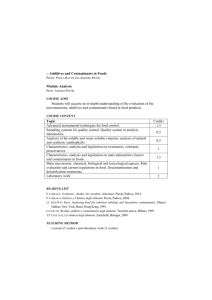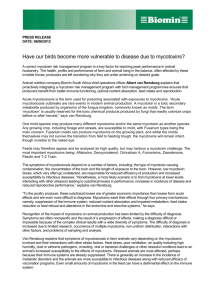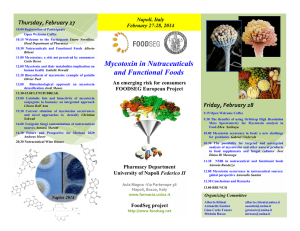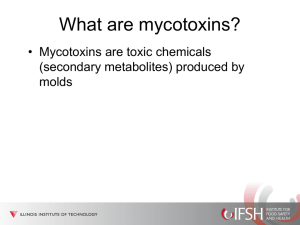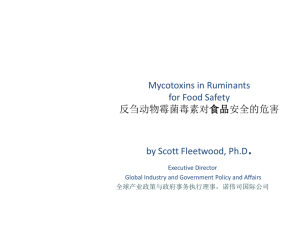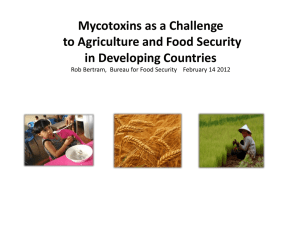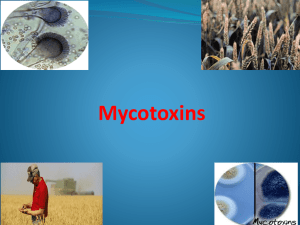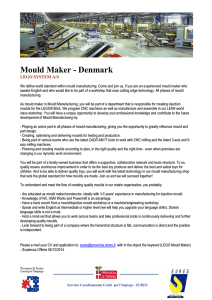Microsoft Word-template
advertisement
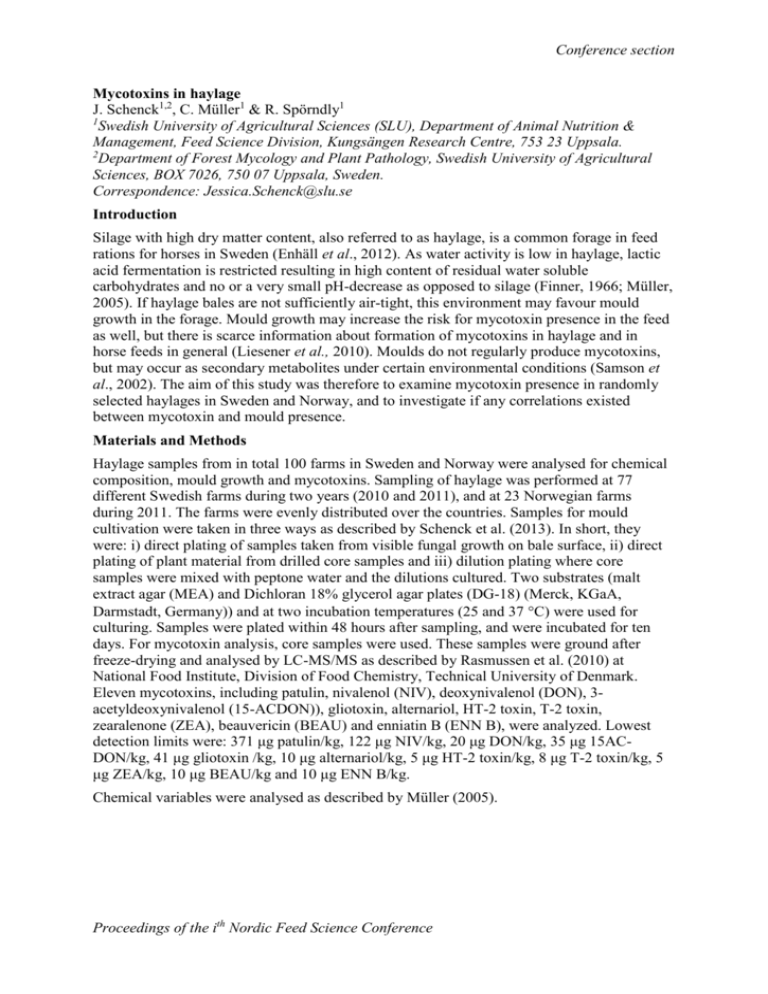
Conference section Mycotoxins in haylage J. Schenck1,2, C. Müller1 & R. Spörndly1 1 Swedish University of Agricultural Sciences (SLU), Department of Animal Nutrition & Management, Feed Science Division, Kungsängen Research Centre, 753 23 Uppsala. 2 Department of Forest Mycology and Plant Pathology, Swedish University of Agricultural Sciences, BOX 7026, 750 07 Uppsala, Sweden. Correspondence: Jessica.Schenck@slu.se Introduction Silage with high dry matter content, also referred to as haylage, is a common forage in feed rations for horses in Sweden (Enhäll et al., 2012). As water activity is low in haylage, lactic acid fermentation is restricted resulting in high content of residual water soluble carbohydrates and no or a very small pH-decrease as opposed to silage (Finner, 1966; Müller, 2005). If haylage bales are not sufficiently air-tight, this environment may favour mould growth in the forage. Mould growth may increase the risk for mycotoxin presence in the feed as well, but there is scarce information about formation of mycotoxins in haylage and in horse feeds in general (Liesener et al., 2010). Moulds do not regularly produce mycotoxins, but may occur as secondary metabolites under certain environmental conditions (Samson et al., 2002). The aim of this study was therefore to examine mycotoxin presence in randomly selected haylages in Sweden and Norway, and to investigate if any correlations existed between mycotoxin and mould presence. Materials and Methods Haylage samples from in total 100 farms in Sweden and Norway were analysed for chemical composition, mould growth and mycotoxins. Sampling of haylage was performed at 77 different Swedish farms during two years (2010 and 2011), and at 23 Norwegian farms during 2011. The farms were evenly distributed over the countries. Samples for mould cultivation were taken in three ways as described by Schenck et al. (2013). In short, they were: i) direct plating of samples taken from visible fungal growth on bale surface, ii) direct plating of plant material from drilled core samples and iii) dilution plating where core samples were mixed with peptone water and the dilutions cultured. Two substrates (malt extract agar (MEA) and Dichloran 18% glycerol agar plates (DG-18) (Merck, KGaA, Darmstadt, Germany)) and at two incubation temperatures (25 and 37 C) were used for culturing. Samples were plated within 48 hours after sampling, and were incubated for ten days. For mycotoxin analysis, core samples were used. These samples were ground after freeze-drying and analysed by LC-MS/MS as described by Rasmussen et al. (2010) at National Food Institute, Division of Food Chemistry, Technical University of Denmark. Eleven mycotoxins, including patulin, nivalenol (NIV), deoxynivalenol (DON), 3acetyldeoxynivalenol (15-ACDON)), gliotoxin, alternariol, HT-2 toxin, T-2 toxin, zearalenone (ZEA), beauvericin (BEAU) and enniatin B (ENN B), were analyzed. Lowest detection limits were: 371 μg patulin/kg, 122 μg NIV/kg, 20 μg DON/kg, 35 μg 15ACDON/kg, 41 μg gliotoxin /kg, 10 μg alternariol/kg, 5 μg HT-2 toxin/kg, 8 μg T-2 toxin/kg, 5 μg ZEA/kg, 10 μg BEAU/kg and 10 μg ENN B/kg. Chemical variables were analysed as described by Müller (2005). Proceedings of the ith Nordic Feed Science Conference Conference section Correlation calculations between presence of mycotoxins and moulds in haylage samples were performed using PROC CORR statement (SAS, 2014). The probability to find mycotoxins was also tested with PROC LOGISTIC model (SAS, 2014), where variables such as presence of mould (any species or Fusarium spp. in particular) and of chemical composition such as dry matter, crude protein, ash, NDF, pH, ammonia nitrogen, lactic acid, acetic acid, propionic acid, butyric acid, ethanol and 2,3-butanediol were included. In all statistical calculations, farm was used as experimental unit and effects were considered as statistically significant when P < 0.05. Results and Discussion One or more mycotoxin(s) were found in haylage from fifty farms, while no mycotoxins were detected in the remaining haylage samples (50) (Figure 1). The most frequently detected mycotoxin was ENN-B (31 farms) followed by BEAU (16 farms) and DON (12 farms).These mycotoxins are all known to be produced by Fusarium species. Minimum, maximum and mean mycotoxin concentrations are reported in Table 1. The level of the second most common mycotoxin found in the present study (BEAU) was low, compared to a recently presented survey from Korea, where the average level of concentrate feeds for cattle was 720 µg/kg (Kyung et al 2010). Wheat bran was identified as the concentrate ingredient containing the highest amount BEAU ranging from 340 to 1100 µg/kg. 50 45 Number of farms 40 35 30 25 20 15 10 5 0 Mykotoxin, µg/kg Figure 1 Mycotoxins detected in haylage sampled from 100 farms in Sweden and Norway and number of farms where each mycotoxin was present. Mould was detected in haylage samples from 49 farms with method ‘’', 74 farms with method ‘ii’, and 56 farms with method ‘iii’. The most common mould genera were Pencillium spp. and Artrinium spp. Fusarium spp. were only detected in haylage from five farms. Proceedings of the ith Nordic Feed Science Conference Conference section Table 1 Mycotoxins detected in haylage samples from 100 Swedish and Norwegian farms (µg/kg). Values only represent samples where the mycotoxins were detected Mycotoxin Minimum Maximum Mean SD Patulin Nd Nd Nd Nd NIV Nd Nd Nd Nd DON 69 479 238 134.7 15- ACDON 70 288 179 154.1 Gliotoxin 44 57 51 9.2 Alternariol 11 1452 212 501.7 HT-2 19 78 35 28.8 T-2 8 11 9 1.5 ZEA 8 8 8 - BEAU 11 988 248 376.8 ENN B 10 283 56 83.9 Nd = value below lower limit of detection (see text for lower detection limits) There was no correlation between mycotoxin presence and mould occurrence (r = 0.03). Thus, finding visible mould at the bale surface or from core samples will not mean that mycotoxins are present. An analysis of the magnitude of total mould growth (log CFU/g) established with the dilution method, and the prevalence of mycotoxins, resulted in an indication that the risk of finding mycotoxins was higher when mould numbers were higher (r = 0.25; P < 0.05). However, higher mould counts were not correlated to higher mycotoxin concentrations (r = 0.03). This is in contrast to the findings of Legzdina and Buerstmayr (2004) who studied Fusarium head blight and mycotoxin presence in barley, where the percentage of visually infected barley spikes was positively correlated with the content of DON and 15-ACDON. It was notable that no correlation was found between occurrence of Fusarium-toxins (NIV, DON, BEAU and ENN-B) and presence of Fusarium spp.-moulds (Fusarium culmorum, Fusarium equiseti, Fusarium graminearum and Fusarium poae) in the haylage samples. However, the small number of haylage samples where Fusarium-moulds were detected may partly explain this. Also, presence of mycotoxin may be a result of previous and not present active mould growth, meaning that the product of the mould is detected but not the mould itself. The difficulty of using other variables as predictors of mycotoxin presence was further highlighted when analysing the data with the LOGISTIC procedure, where the statement SELECTION=FORWARD was used, allowing all chemical variables and mould occurrence that met the significance level of P < 0.05 to enter the model. No variable appeared to statistically increase or decrease the odds ratio to find mycotoxins in the haylage. Conclusions Mycotoxins were detected in 50% of sampled haylage bales in Sweden and Norway. Fusarium spp. mycotoxins were the most common mycotoxins present. Neither conventional mould analysis by culturing nor chemical variables were able to indicate if mycotoxins were Proceedings of the ith Nordic Feed Science Conference Conference section present. However, in bales where moulds occurred, higher mould counts correlated weakly with the presence of mycotoxins. References Enhäll, J., Nordgren, M. & Kättström, H., 2012. Hästhållning i Sverige 2010. The Swedish Board of Agriculture, Report 2012:1. Jönköping, Sweden. Finner, M.F., 1966. Harvesting and handling low-moisture silage. Transact. ASAE 9, 377381. Kyung-Eun, L., Byung Hee, K. & Chan, L., 2010. Occurrence of Fusarium mycotoxin beauvericin in animal feeds in Korea. Anim. Feed Sci. Technol., 157, 190-194. Legzdina, L. & Buerstmayr, H., 2004. Comparison of infection with Fusarium head blight and accumulation of mycotoxins in grain of hulless and covered barley. J. Cereal Sci. 40, 6167. Liesener, K., Curtui, V., Dietrich, R., Märtlbauer, E. & Usleber, E. 2010. Mycotoxins inn horse feed. Mycotox. Res. 26, 23-30. Müller, C. E., 2005. Fermentation patterns of small-bale silage and haylage produced as a feed for horses. Grass Forage Sci. 60, 109-118. Rasmussen, R.R., Storm, I.M.L.D., Rasmussen, P.H., Smedsgaard, J. & Nielsen, K.F., 2010. Multi-mycotoxin analysis of maize silage by LC-MS/MS. Anal. Bioanal. Chem. 397, 765776. Samson, R.A., Hoekstra, E.S., Frisvad, J.C. & Filtenborg, O., 2002. Introduction to food- and airborne fungi. 6th ed. Centralbureau voor Schimmelcultures, Utrecht, The Netherlands. SAS, 2014. SAS 9.3. SAS institute Inc. Cary. NC. USA. Proceedings of the ith Nordic Feed Science Conference
